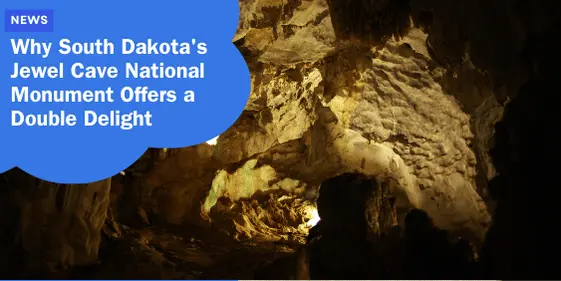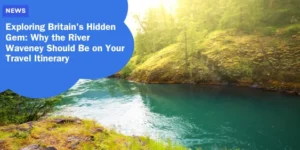Why South Dakota’s Jewel Cave National Monument Offers a Double Delight

Nestled in the heart of South Dakota, Jewel Cave National Monument provides an enchanting experience both below and above ground.
Known for its extensive and intricate underground caverns, as well as the beautiful landscapes that surround it, Jewel Cave is a destination that offers a unique combination of natural beauty and adventure for all who visit.
The Uniqueness of Jewel Cave
Much like its neighbor, Wind Cave National Park, Jewel Cave boasts an impressive array of geological formations that leave visitors in awe.
“Caves are fascinating because they each tell their own unique story,” says Tom Farrell, the chief of Interpretation at Wind Cave National Park.
His sentiment rings true for Jewel Cave as well, where the underground limestone caverns stretch out for miles, creating a labyrinth of tunnels and chambers full of stunning natural formations.
Jewel Cave holds the title of the third longest cave in the world, and its complexity only adds to its allure.
The intricate structures within the cave, including calcite crystals that sparkle like their namesake jewels, make it a visual wonder.
Guides at the park often compare these delicate formations to fragile works of art, beautiful yet susceptible to damage if not handled with care.
Exploring the Depths of Jewel Cave
One of the highlights of visiting Jewel Cave National Monument is the opportunity to explore its vast underground network through ranger-guided tours.
These tours are necessary to ensure the safety of visitors and to protect the delicate cave environment.
“It can be dangerous to navigate the cave without a guide,” Farrell explains, “not to mention the risk of damaging the unique formations.”
Various tours are available, each catering to different levels of adventure and ability.
From the easy and accessible Discovery Tour, which takes visitors through the main caverns, to the challenging Wild Caving Tour that requires crawling and climbing through tight passages, there is an experience for everyone.
Above Ground Beauty
The splendor of Jewel Cave doesn’t end underground.
The monument spans over 1,200 acres of scenic landscapes that offer their own form of beauty.
Visitors are encouraged to explore the surface trails that wind through ponderosa pine forests and open meadows, offering chances to see wildlife such as white-tailed deer, elk, and even the occasional mountain lion.
Birdwatchers will delight in the variety of species that can be spotted, including bald eagles, hawks, and various songbirds.
Accessibility and Visitor Tips
When planning a visit to Jewel Cave, it’s important to consider a few logistical details to ensure a smooth trip.
The monument is located approximately 13 miles west of Custer, South Dakota, and around 54 miles from Rapid City.
While entrance to the monument is free, there are fees associated with the ranger-guided cave tours.
These fees vary depending on the length and difficulty of the tour, typically ranging from $4 to $31.
Advance booking is highly recommended, especially during the peak summer months, as tours can fill up quickly.
Technological Enhancements
An exciting addition to the visitor experience at Jewel Cave is the use of technology to enhance understanding and exploration of the cave.
With areas of the cave still being mapped and discovered, the park has implemented interactive virtual tours that offer insights into inaccessible parts of the cave.
These virtual tours are especially beneficial for visitors with mobility issues or those who experience claustrophobia, allowing them to enjoy the beauty of the cave from the safety and comfort of the visitor center.
Engaging with the Local Community and History
The history and culture associated with Jewel Cave extend beyond its geological wonders.
The area holds significant meaning for various Native American tribes, whose histories and traditions are deeply connected to the land.
The visitor center includes exhibits that narrate these stories, providing a richer, more comprehensive understanding of the monument’s importance.
Through educational programs and collaborations with Native communities, the park aims to honor and preserve this cultural heritage.
Additionally, the conservation efforts at Jewel Cave have played a pivotal role in protecting its ecosystem.
The efforts to reintroduce and protect wildlife species such as the peregrine falcon and the importance of maintaining the integrity of the cave’s environment highlight the ongoing commitment to preserving this natural treasure for future generations.
Fun Facts About Jewel Cave
To round off your understanding and appreciation of Jewel Cave National Monument, here are a few fascinating facts:
- Jewel Cave was discovered in 1900 by Frank and Albert Michaud when they noticed air blowing from a small hole in a canyon.
- The cave’s name comes from the sparkling calcite crystals that line its passageways, which look like precious jewels when illuminated.
- It was proclaimed a national monument by President Theodore Roosevelt in 1908, recognizing its significance and need for protection.
- The cave system is still being explored and mapped; cave explorers have currently mapped over 215 miles of passages, and it’s thought there could be many more miles yet undiscovered.
- Jewel Cave is home to a variety of endemic species, including unique cave spiders and beetles that have adapted to the dark, humid environment.
Planning Your Adventure
Whether you’re an avid spelunker or a nature enthusiast, Jewel Cave National Monument offers a captivating destination that promises to deliver unforgettable memories.
Its combination of intricate underground beauty and serene above-ground landscapes provides a dual experience that is truly unique.
The monument invites visitors to immerse themselves in the natural wonders and rich history it holds, making it a must-visit location in South Dakota.
As you plan your visit, remember to respect the delicate environment of the cave and enjoy the adventure that awaits both below and above the surface.






